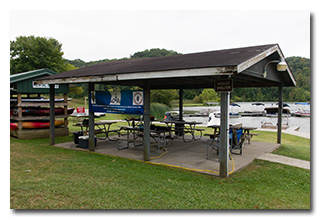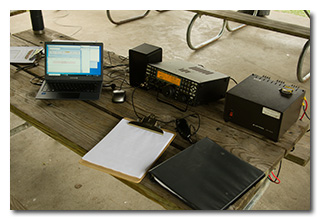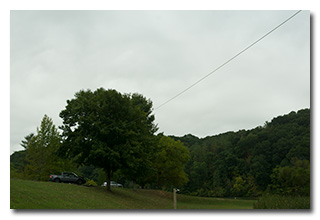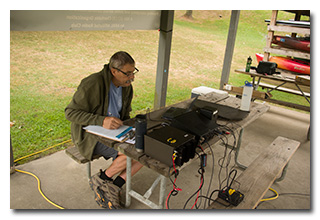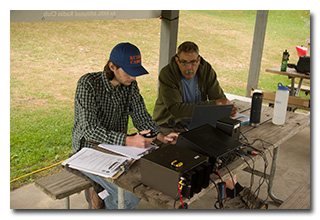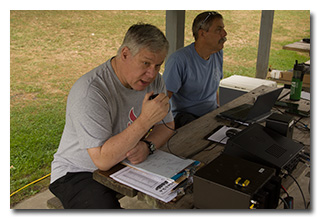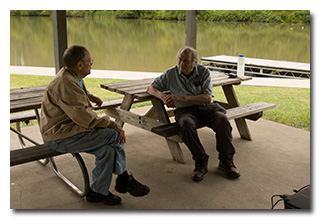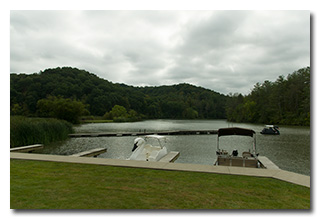
by William Eric McFadden
From the Strouds Run State Park website:
-
Strouds Run State Park is located in the scenic forested hills of Athens County, in the midst of the unglaciated Appalachian Plateau. Although untouched by the vast ice sheets that moved across portions of the state over 12,000 years ago, Strouds Run displays the effects of the glaciers -- in the deep ravines and high hills -- where the valleys served as outlets for torrents of glacial meltwaters. The erosive power of these waters carved the valleys and hillsides, creating the familiar topography Ohioans know today. Large deposits of glacial outwash, primarily sand and gravel, were deposited along these streams and strongly affected the type of biological communities present today.
Sandstone, the principal bedrock outcropping in the region, is very resistant to erosion and forms the uplands and steep sides of the valleys. Twisting roads and forest trails pass through these deep ravines and lead to dense stands of beech, hickory, oak, maple and tuliptree. Seasonal displays are offered by flowering dogwood, redbud and spring wildflowers -- with fall presenting a pageant of colorful foliage. These woods are home to white-tailed deer, fox, raccoon, opossum, squirrel, wild turkey and a variety of songbirds. Woodthrush, white-breasted nuthatch, scarlet tanager, pileated woodpecker and the rufous-sided towhee inhabit the forest canopy. These rugged hills and woodlands are truly reminiscent of the wilderness that characterized the Ohio country in the days of early settlers.
Pictures
- The ACARA OSPOTA Station in the Bobcat Shelter: 1 | 2 | 3
- Paul, WD8SCV, operates
- Cade, KC3EKE, operates while Paul, WD8SCV, logs
- Kirk, KC8JRV, operates while Paul, WD8SCV, logs
- John, N8XWO, and Bob, KD8FRQ, catch up
- Dow Lake as seen from Bobcat Shelter
Description
On Saturday, September 9, 2023, one member of the Southeast Ohio Radio Adventure Team performed a successful activation of Strouds Run State Park (K-1994) as part of the Parks on the Air (POTA; link) program. While participating in the Athens County Amateur Radio Association's Ohio State Parks on the Air (OSPOTA, link) SSB-only activation of Strouds Run State Park (SRN) as W8UKE, Eric McFadden, WD8RIF, performed his own POTA CW activation of Strouds Run State Park (K-1994).
Eric, who is president of ACARA and served as captain for this year's OSPOTA operation, arrived at the Bobcat Picnic Shelter shortly before 1300 UTC and was quickly joined by Paul Schulz, WD8SCV. Paul expertly threw a line threw a well-positioned tree and he and Eric pulled up and secured the 80m end-fed halfwave antenna that Paul had built for the event. Eric set up the ACARA's Elecraft K3 and logging PC on a picnic table in the shelter. Since the Bobcat Shelter had available commercial power, no generator was needed.
OSPOTA started at 1400 UTC and, no other ACARA members having yet arrived, Paul grabbed the mic and the first OSPOTA contact came at 1406 UTC with KD8YPY at Sycamore State Park (SYC). Paul quickly made four more QSOs with operators located at Dillon State Park (DIL), Harrison Lake State Park (HLK), Hueston Woods State Park (HUE), and Deer Creek State Park (DEE).
Eric and Paul were joined at about 1430 UTC by Cade, KC3EKE, who took the mic and, while Paul logged, quickly made fifteen QSOs.
While Cade was banging out QSOs, Eric took the time to set up his POTA station outside the picnic shelter, deploying his 28½' wire vertical on his 31' Jackite telescoping fiberglass mast bungied to his folding camp-chair. He set up his KX3 on his folding camp-chair's flip-up table adjacent to the base of the mast and was on the air at 1444 UTC.
Because Eric was to be on-site for another seven hours, and since the good cell-signal at the site allowed for use of the POTA Spots website (link), Eric had originally planned to perform this activation as a 100% park-to-park (P2P) activation but the gray sky that threatened rain prompted Eric start his operation by running a frequency on 20m.
Eric was pleased that the 100w signal from the ACARA's K3 didn't cause much interference while his KX3 was on 20m, and his own 20m 5w signal didn't introduce interference to the K3.
Eric's first QSO came at 1449 UTC with N7WPO in Washington. QSOs came quickly, with Eric's tenth QSO and a valid activation coming at 1500 UTC with KQ1P in Maine. This run included a P2P QSO with super-activator K4NYM who was performing a two-fer activation of Fort Cooper State Park (K-1870) and Withlacoochee State Trail (K-3667) in Florida and QSOs with operators located in Washington, Idaho, Massachusetts, Minnesota, Florida (3), Texas, Arizona, and Maine.
Pausing to check POTA Spots for P2P QSO opportunities, at 1503 UTC Eric made a P2P QSO on 40m with KE8UEX who was activating Island Lake State Recreation Area (K-3315) in Nebraska.
The ACARA's 100w station caused too much interefence for Eric to want to stay on 40m, so he returned to 20m to run a frequency. Eric's first QSO in this run came at 1516 UTC with W6ZDR in Texas. As before, QSOs came quickly, with Eric's eighteenth QSO coming at 1528 UTC with N1ZX in Florida. This run included QSOs with operators located in Texas (3), Nebraska, and Florida (3).
Eric finished his activation by again checking POTA Spots for P2P QSO opportunities and at 1534 UTC he made a P2P QSO on 20m with WB0RLJ who was activating Chalco Hills State Recreation Area (K-4011) in Nebraska.
Alas—Eric neglected to make any photographs of his POTA station.
Sometime after Eric finished his POTA activation, Cade left and Kirk, KC8JRV, arrived. With Paul's help, Kirk made an OSPOTA QSO on 40m with NF8O at Malabar Farms State Park (MAL).
As has become the custom, other ACARA members arrived about 5pm and turned the OSPOTA operation into a club potluck.
OSPOTA QSOs were made by three ACARA members. Paul, WD8SCV, made eighty-five QSOs; Cade made fifteen QSOs; and Kirk, KC8JRV, made one QSO; for a total of 101 QSOs. Stations were worked in forty-two Ohio State Parks, for a calculated score of 4,343 points.
Only one problem was encountered with the ACARA's station. Several stations worked reported that the ACARA's transmitted audio had a pronounced hum. To diagnose this, Eric first swapped the Astron linear power supply for a 15Ah Bioenno LiFePO4 battery, and then coiled the antenna feedline into a choke near the transceiver. Neither of these actions killed the hum. It was only after Eric unplugged the logging-computer's switching power supply—as suggested by John, N8XWO—that the hum went away. Fortunately, the laptop PC's battery retained enough charge that the OSPOTA operation could be completed without having the logging PC plugged in. (Eric will try to resolve this issue by putting chokes on the laptop DC power-supply cord.)
This was the first time the ACARA has operated from the Bobcat Shelter. (The Bobcat Shelter was used this year only because when Eric tried to reserve the usual OSPOTA location, the Bulldog Shelter, it had already been reserved for the day by another group.) The Bobcat Shelter was smaller than the Bulldog shelter, and it was located in a busy area between the boat-rental area and the swim beach, but smaller space and the foot-traffic didn't cause a problem, and the traffic of canoes, kayaks, paddleboards, pontoon boats, and pedal-powered swan-boats also didn't cause any problems except for occasional person walking up to the radio station to try to rent a boat.
(return)
